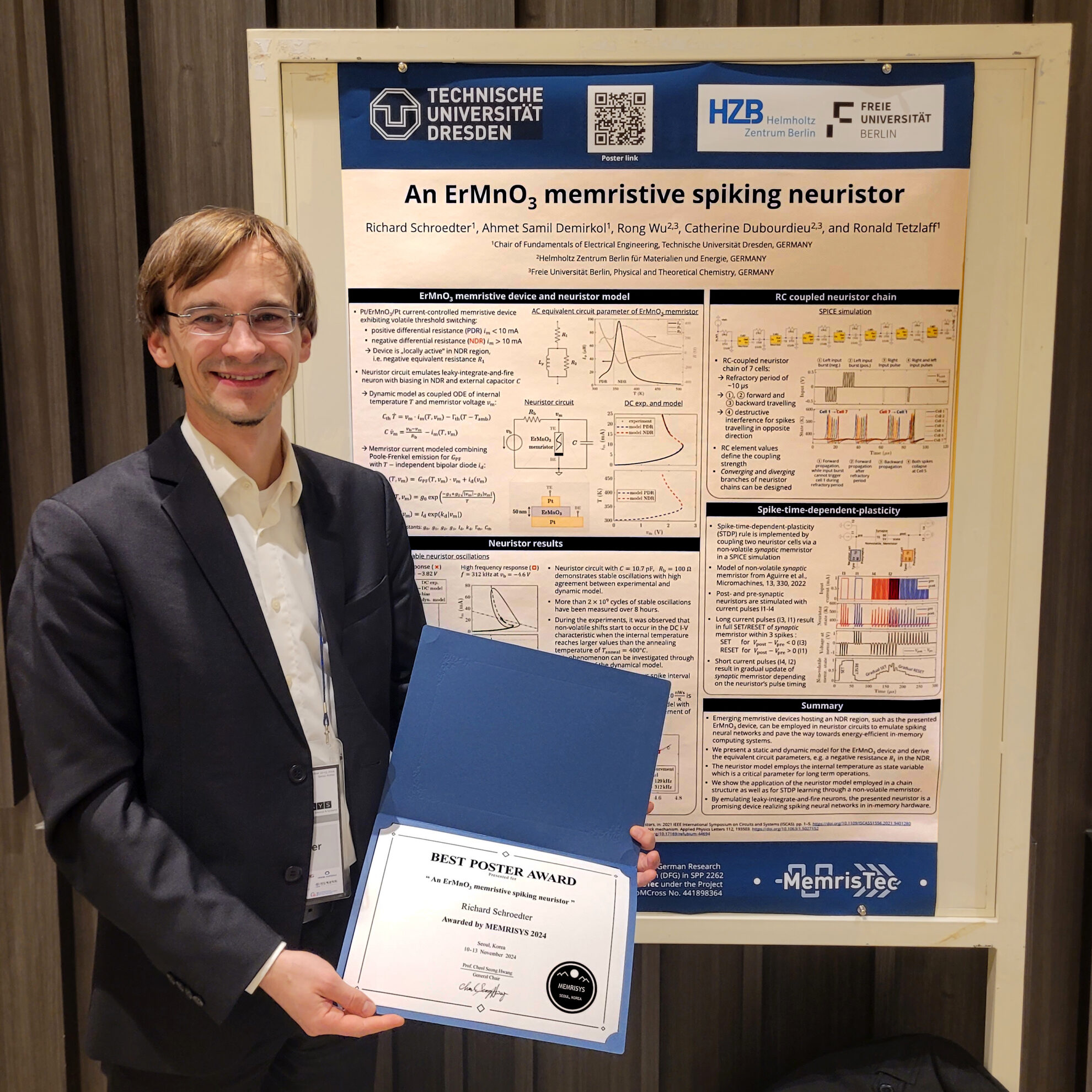Richard Schroedter, Ahmet Samil Demirkol, Ioannis Messaris, Christian Bruchatz, Eter Mgeladze, Stefan Slesazeck
2025 14th International Conference on Modern Circuits and Systems Technologies (MOCAST), 11-13 June 2025
Richard Schroedter, Ahmet Samil Demirkol, Ioannis Messaris, Christian Bruchatz, Eter Mgeladze, Stefan Slesazeck
2025 14th International Conference on Modern Circuits and Systems Technologies (MOCAST), 11-13 June 2025
R. Schroedter, A.S. Demirkol, R. Wu, C. Dubourdieu, and R. Tetzlaff presented their work “An ErMnO₃ memristive spiking neuristor” at the International Conference on Memristive Materials, Devices & Systems (MEMRISYS 2024) on 11 November 2024.The presentation was honored with the Best Poster Award, highlighting the innovative contributions of the NeuroMCross project within the MemrisTec Priority Program (SPP).
Richard Schroedter, Adnan Haidar, Ronald Tetzlaff
13th International Conference on Modern Circuits and Systems Technologies (MOCAST), 26-28 June 2024
Brain-inspired Spiking Neural Networks (SNNs) operate in parallel and asynchronously via spatio-temporal spikings of interconnected neurons. Capacitive neural networks that charge and discharge capacitive mem-elements, resulting in the removal or return of energy from/to the signal sources, can lead to considerably lower energy consumption in comparison to conventional artificial neural network (ANN) structures performing massively matrix-vector multiplications. In this regards memtransistor neurons combining memristive/memcapacitive devices and transistor structures can enable fundamental features of neurons like the leaky-integrate-and-fire (LIF) behavior. This can be built into a neuromorphic memcomputing building block for versatile SNN architectures. In this project we aim at the development of a novel neuro-crossbar structure, which combines and extends the functionalities of the individual components of the memristive/memcapacitive crossbar and neurotransistor based on Al2O3/Nb2O5 devices developed in the preceding BioMCross project. Unlike previous memtransistor approaches, we fabricate an integrated multi-input memcapacitive crossbar structure at the gate of a silicon-based n-channel field effect transistor (nFET), which is able to create a controlled 1D and 2D percolation path along the transistor channel. The LIF neuro-crossbar integrates high complexity, such as a fully connected layer for multiple inputs, an all-or-nothing feature extraction for 1D percolation or OR-linked 2D percolation paths as well as recurrent connection in a single device structure. For this purpose, the proposed work will cover several essential aspects: (i) the neuro-crossbar device modeling using 3D TCAD simulation, (ii) the neuro-crossbar fabrication and parameter optimization by integration of multiple Al2O3/Nb2O5 memristive/memcapacitive devices on top of the transistor structure, (iii) the neuro-crossbar circuit system modeling and analysis of read/write operation and (iv) the design of temporal coded signals for recurrent SNNs, hardware-aware offline training, performance optimization as well as implementation of local learning rules. Finally, we will investigate various time series datasets to demonstrate the realization of recurrent SNNs interconnected neuro-crossbar structures and evaluate the system’s performance compared to conventional CMOS-based SNN and purely memristive ANN accelerator systems. This research aims to extend the state of the art by a new neuro-crossbar building block and to provide a comprehensive understanding of the feasibility of practical realization of memcapacitive SNN systems based on highly integrated device concepts.
